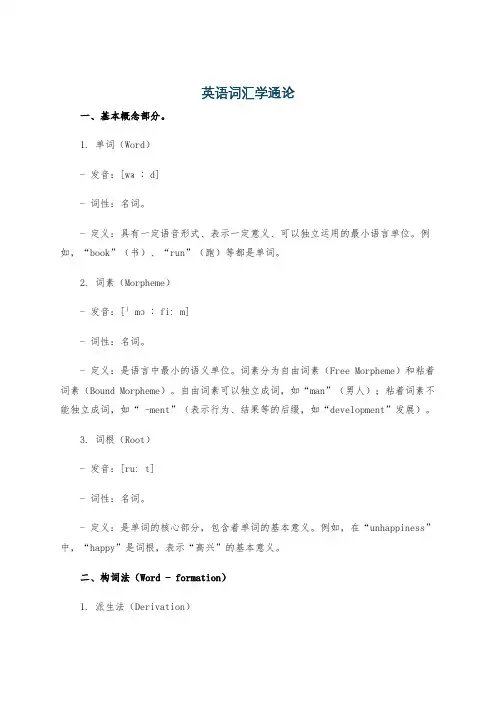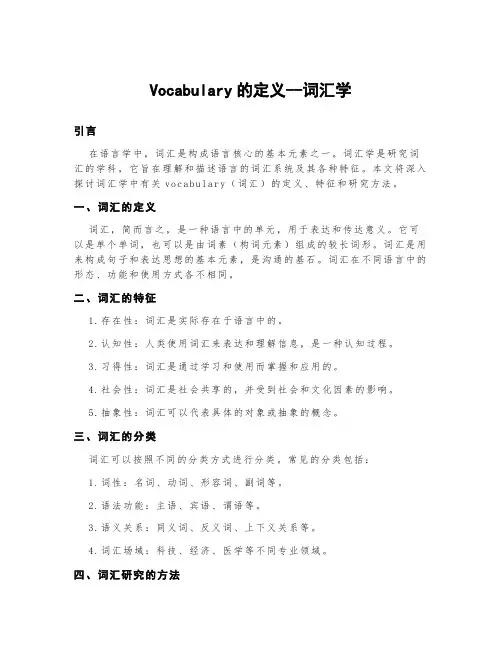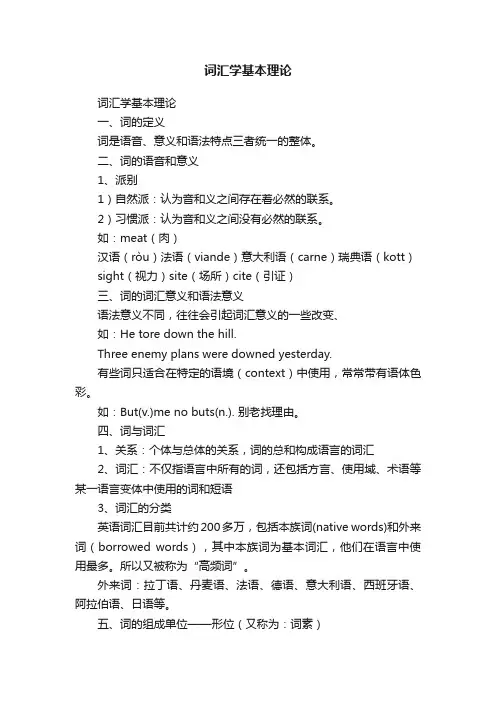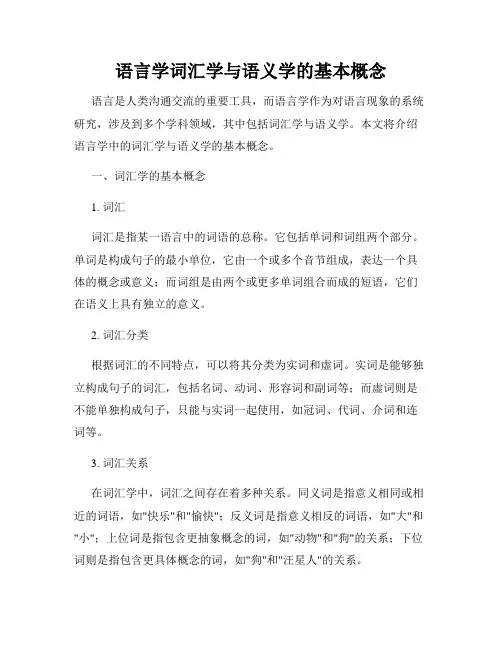词汇与词汇学的基本概念
- 格式:docx
- 大小:24.00 KB
- 文档页数:5

英语词汇学通论一、基本概念部分。
1. 单词(Word)- 发音:[wɜːd]- 词性:名词。
- 定义:具有一定语音形式、表示一定意义、可以独立运用的最小语言单位。
例如,“book”(书)、“run”(跑)等都是单词。
2. 词素(Morpheme)- 发音:[ˈmɔːfiːm]- 词性:名词。
- 定义:是语言中最小的语义单位。
词素分为自由词素(Free Morpheme)和粘着词素(Bound Morpheme)。
自由词素可以独立成词,如“man”(男人);粘着词素不能独立成词,如“ -ment”(表示行为、结果等的后缀,如“development”发展)。
3. 词根(Root)- 发音:[ruːt]- 词性:名词。
- 定义:是单词的核心部分,包含着单词的基本意义。
例如,在“unhappiness”中,“happy”是词根,表示“高兴”的基本意义。
二、构词法(Word - formation)1. 派生法(Derivation)- 发音:[ˌderɪˈveɪʃn]- 词性:名词。
- 解释:通过在词根上加前缀(Prefix)或后缀(Suffix)来构成新词的方法。
- 示例:- 加前缀:“un -”(表示否定) + “happy”(高兴的) = “unhappy”(不高兴的),“un -”的发音是[ʌn]。
- 加后缀:“teach”(教)+“ -er”(表示人) = “teacher”(教师),“ -er”的发音是[ə(r)]。
2. 合成法(Compounding)- 发音:[kəmˈpaʊndɪŋ]- 词性:名词。
- 解释:把两个或两个以上的词组合成一个新词的方法。
- 示例:- “black”(黑色的)+“board”(木板) = “blackboard”(黑板),“black”发音为[blæk],“board”发音为[bɔːd]。
- “day”(天)+“break”(打破,破晓) = “daybreak”(黎明),“day”发音为[deɪ],“break”发音为[breɪk]。

现代汉语讲义-词汇-词汇概说目的要求1、掌握语素的含义及其分类2、掌握语素与汉字、语素与词的关系3、掌握词与词组、词与词汇的区别一、词汇学的分科与研究对象(一)词汇学的分科词汇学是以词和词汇为研究对象的一门语言学科。
可分为普通词汇学与具体语言词汇学两大类。
1、普通词汇学又称一般词汇学,是普通语言学的一个组成部分。
它以多种语言中的词汇现象为研究对象,从而总结出一般性的规律。
2、具体语言词汇学又称个别语言词汇学,以一种语言中的词汇现象为研究对象。
从历时与共时角度划分,又分为历史词汇学、历史比较词汇学与描写词汇学等。
(1)历时词汇学主要研究词汇在语言发展过程中的的演变规律。
比如汉语词汇史主要研究汉语词汇在上古、中古、近古不同历史阶段中的发展情况。
而上古词汇史则研究汉语词汇在殷商、先秦、两汉时期的演变规律,一般以文献记载的材料或所发掘的相关出土文物为研究对象。
(2)历史比较词汇学主要是运用历史比较方法,研究有亲属关系的多种语言中的词汇问题。
比如汉藏词汇比较研究,则侧重于考察不同词汇词语间的共源关系以及各自不同的演变规律。
(3)描写词汇学是研究语言词汇在一定阶段,一般指现阶段的特点。
(二)现代汉语描写词汇学的研究对象主要涉及以下几个方面的内容:词的性质,词的造词与构词,词义的类型,词义的特征,词义的类聚,词义的发展,词汇的构成与演变等。
二、语素、词、词汇(一)语素(morepheme)1.什么是语素1.1定义:语素是语言中最小的音义结合体。
1.2特点:(1)有声音:好/人(2)有意义:蝴蝶玻璃新加坡麦当劳(3)最小:桌子(2个语素)巧克力(1个语素)(4)功能是构词:好:好看/好吃;人:人民/人情2.语素的分类2.1按语音形式划分(1)单音语素:手灯/走观/红绿/男女/一千/条个/吗的(2)多音语素:乌鲁木齐新加坡香港(源自莞香装运地/源自海盗香姑的名字)2.2按语言功能划分(1)成词语素指可以独立成词的语素,也叫自由语素。


Vocabulary的定义--词汇学引言在语言学中,词汇是构成语言核心的基本元素之一。
词汇学是研究词汇的学科,它旨在理解和描述语言的词汇系统及其各种特征。
本文将深入探讨词汇学中有关vo c ab ul ar y(词汇)的定义、特征和研究方法。
一、词汇的定义词汇,简而言之,是一种语言中的单元,用于表达和传达意义。
它可以是单个单词,也可以是由词素(构词元素)组成的较长词形。
词汇是用来构成句子和表达思想的基本元素,是沟通的基石。
词汇在不同语言中的形态、功能和使用方式各不相同。
二、词汇的特征1.存在性:词汇是实际存在于语言中的。
2.认知性:人类使用词汇来表达和理解信息,是一种认知过程。
3.习得性:词汇是通过学习和使用而掌握和应用的。
4.社会性:词汇是社会共享的,并受到社会和文化因素的影响。
5.抽象性:词汇可以代表具体的对象或抽象的概念。
三、词汇的分类词汇可以按照不同的分类方式进行分类。
常见的分类包括:1.词性:名词、动词、形容词、副词等。
2.语法功能:主语、宾语、谓语等。
3.语义关系:同义词、反义词、上下义关系等。
4.词汇场域:科技、经济、医学等不同专业领域。
四、词汇研究的方法词汇学研究词汇的特征、变化和演变,使用了多种方法,包括:1.语料库研究:通过收集和分析实际语言使用的大量样本,来揭示词汇的频率、用法和意义。
2.语言测试:通过语言测试来评估词汇的掌握程度,了解学习者的词汇水平和发展。
3.调查问卷:通过设计问卷来了解人们对特定词汇和用法的态度和理解。
4.语义分析:使用语义学的方法来研究词汇的意义、语境和语用功能。
结论词汇学是一门研究词汇的学科,通过对词汇的定义、特征和研究方法的探讨,我们可以更好地理解语言中的词汇现象。
词汇在语言中起着重要的作用,它是表达和沟通思想的关键。
通过深入研究词汇,我们可以提高语言能力,理解语言变化和文化差异,进而更好地运用语言进行交流和沟通。
希望本文对词汇学的学习和理解有所帮助。

词汇学基本理论词汇学基本理论一、词的定义词是语音、意义和语法特点三者统一的整体。
二、词的语音和意义1、派别1)自然派:认为音和义之间存在着必然的联系。
2)习惯派:认为音和义之间没有必然的联系。
如:meat(肉)汉语(ròu)法语(viande)意大利语(carne)瑞典语(kott)sight(视力)site(场所)cite(引证)三、词的词汇意义和语法意义语法意义不同,往往会引起词汇意义的一些改变、如:He tore down the hill.Three enemy plans were downed yesterday.有些词只适合在特定的语境(context)中使用,常常带有语体色彩。
如:But(v.)me no buts(n.). 别老找理由。
四、词与词汇1、关系:个体与总体的关系,词的总和构成语言的词汇2、词汇:不仅指语言中所有的词,还包括方言、使用域、术语等某一语言变体中使用的词和短语3、词汇的分类英语词汇目前共计约200多万,包括本族词(native words)和外来词(borrowed words),其中本族词为基本词汇,他们在语言中使用最多。
所以又被称为“高频词”。
外来词:拉丁语、丹麦语、法语、德语、意大利语、西班牙语、阿拉伯语、日语等。
五、词的组成单位——形位(又称为:词素)1、形位的概念:是最小的语法单位,也是最小的语义单位。
2、类型:词是由形位构成的,有的词只有一个形位,如log, clerk solider等,有的词有多个形位,如lovely有love 和ly 两个形位,unfriendly有un,friend,ly 三个形位。
六、实义形位、语法形位1)实义形位:构成词的语义基础,可以单独使用,有独立的意义,所以又称为自由形位或自由词素。
这种形位相当于词根(root)如:teacher中的teach 2)语法形位:只表示附加意义或语法意义,必须依附于其他形位与之结合才能使用,所以,又被称之为“粘附形位”或“粘附词素”。

语言学词汇学与语义学的基本概念语言是人类沟通交流的重要工具,而语言学作为对语言现象的系统研究,涉及到多个学科领域,其中包括词汇学与语义学。
本文将介绍语言学中的词汇学与语义学的基本概念。
一、词汇学的基本概念1. 词汇词汇是指某一语言中的词语的总称。
它包括单词和词组两个部分。
单词是构成句子的最小单位,它由一个或多个音节组成,表达一个具体的概念或意义;而词组是由两个或更多单词组合而成的短语,它们在语义上具有独立的意义。
2. 词汇分类根据词汇的不同特点,可以将其分类为实词和虚词。
实词是能够独立构成句子的词汇,包括名词、动词、形容词和副词等;而虚词则是不能单独构成句子,只能与实词一起使用,如冠词、代词、介词和连词等。
3. 词汇关系在词汇学中,词汇之间存在着多种关系。
同义词是指意义相同或相近的词语,如"快乐"和"愉快";反义词是指意义相反的词语,如"大"和"小";上位词是指包含更抽象概念的词,如"动物"和"狗"的关系;下位词则是指包含更具体概念的词,如"狗"和"汪星人"的关系。
二、语义学的基本概念1. 语义语义是指词语或句子所包含的意义。
它通过语言符号与现实世界之间的关联来实现。
语义研究的重点是词义和句义。
2. 词义词义是指一个词所表达的基本意义。
它可以通过定义、释义或者示例来描述。
词义的形成主要受到语境的影响,同一个词在不同的语境中可能有着不同的意义。
3. 句义句义是指一个句子所表达的意义。
句义由句子中词语的语法关系、语义关系以及上下文的语境所决定。
一个句子的句义不仅仅是简单词义的组合,还包括更深层次的逻辑和推理。
三、词汇学与语义学的关系词汇学研究的是词汇的形态、分类和关系等问题,而语义学则关注词汇的意义以及句子和篇章的意义构建。
两者之间密切相关,相互交叉影响。
词汇和词汇学词汇和词汇学作为语言学中重要的一环,在检视我们语言的本质,研究语言的发展历史,以及探究语言的结构和运用特点方面,都发挥着不可忽视的作用。
语言是人类文明的标志,而词汇便是这一特性的重要内容之一,因而词汇学的研究在现代语言学中占据着重要地位。
词汇学的定义是解释语言词汇如何形成,如何发展,如何被使用来表达意义。
在词汇学研究中,人们探讨词汇认识,词汇习得,词汇分析,词汇掌握,词汇教学,以及词汇学理论,等等。
词汇学既是语言学得普遍性原理,又是解决有关语言的各种具体问题的重要工具。
词汇学的研究不仅有助于解释和理解语言的本质,同时也反映出语言学习和教学的方法。
词汇学的研究是从英语的词汇学开始的,以及其他欧洲语言的词汇学。
发展到近代语言学,词汇学已经发展成为一门独立的学科,并且不仅仅对欧洲语言产生了重要影响,也对全球语言有着重要的引领作用。
从古典语言学到跨语言和跨文化的研究,词汇学一直在研究和开发自己的知识体系,发展出不同的理论模型,以帮助人们更好地理解语言。
因此,词汇学的研究可以帮助我们掌握语言的本质,从而更好地理解语言学习与教学,同时也可以帮助我们更深入地探究语言的发展及其运用方面的特点。
词汇学有着复杂的理论框架,它是语言学研究中一门相当重要的学科。
其内容涉及词汇习得,词汇分析,词汇社会学理论,社会语言学及语义学等多个方面。
每一个研究的方面都有不同的理论模型,从而可以帮助我们更全面和深入地了解词汇的本质,以及它在语言发展及使用过程中发挥的作用。
词汇学的研究不仅仅是一种语言的研究,也展示了不同语言之间的联系。
研究者借助对词汇的研究,可以理解不同语言的异同,追溯语言的发展历史,以及探究语言文化之间的关系。
因此,词汇学的研究无论是从学术角度还是从语言文化角度,都有助于我们更好地理解词汇及其在语言发展过程中发挥的作用。
综上所述,词汇和词汇学都是语言学中重要的一环,它们发挥着不可忽视的作用。
无论是从学术角度还是从语言文化角度,词汇的研究都有助于我们认识语言的本质,深入探究语言的发展历史,以及更好地了解语言的结构和运用特点。
词汇学知识点总结词汇学是研究词汇的学科,它是语言学的一个重要分支,涉及了语言的构成、变化和使用等方面。
词汇学对于语言的理解和应用具有重要的意义,它不仅可以帮助我们更好地掌握语言知识,还可以帮助我们提高语言运用能力。
在这篇文章中,我们将对词汇学的知识点进行总结,帮助读者更好地理解和掌握这一学科。
一、词的定义和分类词是语言中的最小意义单位,是构成句子和表达意思的基本单位。
按照在句子中的功能和语法特征,词可以分为实词和虚词两大类。
实词包括名词、动词、形容词、副词等,它们能够表示具体的事物或抽象的概念;虚词包括代词、连词、介词、助词等,它们通常用来连接或修饰实词,没有明确的词义。
二、词汇的构成词汇的构成是指词的组成方式和形态特征。
在词汇的构成中,我们可以看到一些常见的构词法,如前缀、后缀、派生、合成、转化等。
通过这些构词法,我们可以对词汇进行灵活组合和创造,丰富语言的表达能力。
1.前缀前缀是指加在词根前面的一个字,可以改变词的词义或语法特征。
比如,“un-”表示否定,“re-”表示再次,“pre-”表示在前面等。
2.后缀后缀是指加在词根后面的一个字,同样可以改变词的词义或语法特征。
比如,“-ing”表示进行时,“-ful”表示充满的意思,“-ment”表示名词化等。
3.派生派生是指通过词根和词缀的组合来创造和衍生新的词。
比如,“happy”是一个形容词,通过加上“-ness”后缀就可以派生出名词“happiness”。
4.合成合成是指两个或多个词汇组合在一起,形成一个新的词。
比如,“blackboard”由“black”和“board”两个实词组合而成。
5.转化转化是指一个词汇的词类发生改变,但词形不变。
比如,“work”可以作为动词,也可以作为名词,它的词形都不发生变化。
词汇的构成方式是多种多样的,通过学习这些构词法,我们可以更好地理解和掌握词汇的形态特征,有助于提高我们的语言表达能力。
三、词汇的语义特征语义是指词汇所携带的意义,它是语言交流和理解的基础。
专业课笔记 | 词汇学 | 符淮青《现代汉语词汇》第一章绪论词汇学与词汇词汇学:以语言中的词汇为研究对象的学科,是语言学的分支之一词汇:语言中词语的总和,包括词和固定语固定语:语言中可以把词作为构成部分的、同词一样作为一个整体来运用的语言单位。
包括熟语和专门用语词汇学分类普通词汇学(一般词汇学):研究词汇的普遍规律具体词汇学(个别词汇学):如汉语词汇学、英语词汇学等汉语词汇学汉语历史词汇学:历时发展演变汉语描写词汇学:共时某时现象上古汉语词汇学中古汉语词汇学近代汉语词汇学现代汉语词汇学-本课内容词汇学的产生和发展(了解)前身:中国古代语言研究三“小学”—音韵学、训诂学、文字学古代语言学名著《尔雅》训诂学第一本义类词典《方言》用通言解释方言《释名》语言考理据《说文解字》第一本文字学书籍字形考理据“五四”—40年代以来词汇研究汉语词汇学建立与发展20c50y:汉语词汇学真正建立:涌现了一批专家与著作,确定研究的对象、任务和范围60y:研究方法更新,词语意义的结构70y:引进义素分析法80y:由定性研究逐渐转为定量研究21c初:计量分析主导词汇学研究总体情况词汇学研究内容:以现代汉语词汇为研究对象,研究词的性质、创造和结构、词义内容、词义发展、词的各种关系、词汇划分与关系等现代汉语词汇特点语素以单音节为主,词以双音节为主,但单音节词使用频率更高多音节词主要来源古代汉语:仿佛徘徊犹豫其他语言:咖啡巧克力沙发词语呈现双音化趋势为什么?内在驱动力:词义表达复杂化的需求与有限词形之间的矛盾社会发展:旧词新义、音变构词、两个词复合构词语音系统简化(避免同音)明确表意:新产生的双音词意义明确;原有单音节词部分义项被取代而减少审美追求(双音节的韵律形式)句法词汇化受外来词影响结果:长度增加,表义明确途径单音节语素前或后加上辅助性相关成分:眼泪头发毛笔松鼠月亮眉毛单音节语素的前面或后面添加一个不表示具体意义的附加成分:老虎阿姨桌子石头意义相同、相近或相对的单音节语素联合起来使用:国家意义寻找牙齿皮肤忘记停止单音节语素重叠:哥哥妈妈爸爸仅仅静静紧紧星星单音节词替换成与原语素无关的双音节词:眼睛(目)筷子(箸)匣子(椟)大腿(股)三音节词省略其中一个因素照相机—相机外国语—外语电视机—电视四音节及其以上的词语缩略:对外贸易—外贸国有企业—国企复合词为主,内部构造与短语大体一致:并列偏正动宾动补主谓同义词数量多,同音语素多:适应不同需要,之间互补,具有多样性和可伸缩性词汇与非词汇界限模糊,切词困难语素构词理据性强,即语素义对词义有明显提示作用少量语素构成大量合成词缺少词形变化成语一般由四个音节组成音节相对而言较短量词、语气词丰富离合词多,使用频率高叠音词多,重叠形式较为丰富词汇学与语言学相关学科的关系(了解)与语音学:语音是语言的物质外壳,是词语的存在形式词的意义靠语音手段来表现,语音是词的音响形式。
语言学核心知识点导言语言学是研究语言的科学,涉及语言的结构、发展、变化、习得等方面。
掌握语言学的核心知识点对于理解和分析语言现象至关重要。
本文将介绍一些重要的语言学核心知识点,以帮助读者深入了解语言学的基本概念和原理。
一、语音学语音学是研究语音系统的学科。
它关注的核心知识点包括音位、音位组合规则、音系、音变规律等。
音位是指语言中具有区别意义的最小语音单位。
不同语言的音位有所不同,比如英语中的/b/和/p/是不同的音位。
音位组合规则研究音位如何组合成词和句。
音系是指某一语言中所有的音位及其组合规则。
音变规律研究语言中音位的变化规律,比如英语中的/t/在单词结尾发音时可能变为/d/。
二、词汇学词汇学是研究词汇的学科。
它关注的核心知识点包括词的定义、构词法、词义、词汇网络等。
词是语言中的基本构成单位,具有一定的形式和意义。
构词法研究如何通过特定的规则构造新词。
词义研究词汇的意义和语境中的含义。
词汇网络研究词汇之间的关联和联系,比如同义词、反义词等。
三、句法学句法学是研究句子结构的学科。
它关注的核心知识点包括短语、句子成分、句子类型、句子结构等。
短语是指由几个词构成的有意义的单位,可以是名词短语、动词短语等。
句子成分研究句子中的各个组成部分,比如主语、谓语、宾语等。
句子类型研究不同类型的句子结构和语法规则,比如陈述句、疑问句等。
句子结构研究句子内部各个成分的排列顺序和关系。
四、语义学语义学是研究句子含义的学科。
它关注的核心知识点包括词义、句义、语用学等。
词义研究词的具体含义和义项,如形容词的描述性义和评价义。
句义研究句子的整体含义和逻辑关系,如假设、推理等。
语用学研究语言使用的上下文和交际功能,如言外之意、言外之意等。
五、语篇学语篇学是研究连续语言材料的学科。
它关注的核心知识点包括信息结构、语段、修辞学等。
信息结构研究语言材料的信息组织方式,如主题句和衔接词的使用。
语段研究语言材料的段落和篇章结构,如起承转合、总分结构等。
第一章词汇与词汇学的基本概念词汇学学习之初,有必要去澄清一些关于词和词汇的基本概念。
词语word是一个难以捉摸的概念,需要在开始就认真关注。
发音和意义之间的关系,声音和形式之间的关系,词语和词汇之间的关系。
另外,我们将注意一些关于词汇分类的共识的规则,并且在本章一定程度上研究每类词语。
1.1一个词是什么?词语是什么?多年来已经引起了语言学家的关注。
争议较大。
尽管已经提出了很多的定义,没有一个是最好的。
学者们仍然没有在词语的定义上达成一致。
当我们谈起一个词语,我们倾向于根据视觉条件来思考。
在这个角度,一个词可以被定义为平印在或者写在纸上的字母的有意义的集合。
当根据口语定义的时候,词被看成是一个发音或发音的集合,是由人的发音器官自由的发出的。
根据语义学家的意见,一个词是一个意义单位。
语法学家,则认为一个词是在句中起作用的自由形式。
等等。
总结起来,词语的定义包含以下几点:(1)一个最小的自由形态(2)一个发音的集合体(3)一个意义单位(4)能独自影响句子的形式因此,我们能说“词语是语言最小的自由形式,拥有固定的声音和意义以及句法作用。
”词语可以是简单词或者合成词,然而全部必须服从这些标准。
Man和fine是简单词,但是他们都有读音,意义和句法意义。
每个都能单独出现在句子中。
自然他们都是词。
也有像是misfortune和management这样的复合词,他们都是多音节词,可以用来作主语,宾语和预示性词语。
尽管misfortune可以被进一步分为mis和fortune,前者不能作为词单独使用。
相似的,management可以被分成manage和ment,但是后者不能自由使用。
Blackmail能被分为black和mail,而且都能作为独立的句子单位使用,然而词的意思绝对不是两个部分的组合。
Black是颜色,针对white,mail指示“被邮局运送的东西”,然而当它们放在一起,组合形式意味着“强迫,利用不光彩的秘密要人送钱或行动作为答复。
”因此blackmail是一个不同的词。
1.2读音和意义词语是一个符号,代表着世界上其他的事物。
每种世界文化已经赞成一定的读音将代表一定的人,事,地方,特性,过程,行动,当然是在语言系统之外。
这种象征性的联系几乎总是主观的,并且“在代表事物和思想的声音和实际的事物和思想之间没有法定关系。
”一只狗被称作“狗”,并不是因为那读音和三个字母能自动的指示那讨论中的动物。
它只是象征性的。
它们之间的关系是约定俗成的,因为同种语言的人们赞成用一串声音说那动物。
在不同的语言中相同的概念可以用不同的声音表达。
Woman,在德语中是frau,在法语中是femme。
在中国话中是funu。
另一方面,相同的读音也表示不同的意义,如mi:t用来表示会议,肉和边界。
骑士和夜晚,尽管代表不同的事物,仍然有相同的读音。
1.3读音和形式通常认为,自然语言的书写形式是口语形式的书写记录。
自然书写形式应该和口语形式相一致。
换而言之,发音应该和形式相一致。
这在英语中是相当正确的在早期也就是古代英语中。
那时候的口语比今天更忠实的代表书面语。
随着语言的发展,越来越多的不同出现在口语和书面语之间。
内因是因为英语字母表采用罗马字母,罗马字母没有独立的字母代表每个读音,因此一些字母代表两个读音或者组合在一起发音。
Alphabet字母表另一个原因是发音比拼写的变化快,在一些时候还拉开了距离。
在最近五百年里,尽管口语发音已经出现了显著的变化,却没有相应的拼写变化。
第三个原因是一些早期的书写员发明了一些不同。
在早年拼写差别不是问题,因为人们不常看印刷体,而且拼写不像今天这样固定。
结果,没人能够肯定一些英语词汇该如何拼写。
有时候人们故意把拼写改变为一条直线或者只是为了方便识记。
在印刷术传到英国以前,每样东西都是手写的。
那些书写员,那些靠为他人写作谋生的人经常繁忙工作,为了应付国王,主教和商人的需要。
一个问题是几个字母用简短垂直的笔画书写象是iuvmw和n都看上去很相像。
因此,他们的书写体引起了误解。
为了部分解决这个问题,他们把mnv之前的u 改成o.这就是sum cum wuman wunder变成some come woman wonder monk的原因。
某些时候,书记员可能认为没有单词应该以u或者v结尾。
因此,及时的,e被加入那样的词语象是live have true 但是没有发音。
At some point在某个时候到1500年年末,印刷已经变得非常普及。
它有助于固定单词的拼写。
标准化使得拼写不容改变。
字典在拼写终结中得到好处。
同时,读音继续如往常变化,以此带来了更多的不同。
最后借词来了,这是丰富英语词汇的重要途径。
当英语从其他语言中借鉴单词时,它同样借用了拼写。
早期的借词被同化,后来的则不再遵守英语的发音和拼写规则,例如……英语的书写因此是发音形式不完善的代表。
历史上一次又一次,一些英美学者尝试去改革英语的拼写,但是不成功。
尽管差别,至少百分之八十的单词读音和拼写一致。
就算是那些拼写不规范的也有更多的规律和用处,超出我们的认识。
例如,象是hymn condemn bomb他们的最后一个字母是不发音的。
但是他们扩展为更长的单词,沉默的字母就要发音,hymnal1.4词汇所有一种语言中的词构成了它的词汇。
术语“词汇”使用在不同的地方。
他不仅用来代表一种语言中的单词总数,他还能代表所有特定历史时期的单词,例如古代英语词汇,中古词汇和现代英语词汇。
我们也用他来代表所有特定方言的词汇,一本书的词汇,一种学术的词汇和一个人的词汇。
英语是高度发展的世界语言之一。
自然词汇是最大最丰富的之一。
今天的英语笼统估计词汇量超过100万。
1.5词类英语词汇由所有种类的词汇组成。
它们可以根据不同的标准或者不同的目的进行分类。
根据使用频率,单词可以分为基础词和非基础词。
可以根据概念分成实词和虚词,可以根据来源分为本地词和借词。
1.5.1基础词和非基础词基础词是几世纪积累的词汇的基础,构成语言的核心。
尽管基础词占英语词汇比例小,它仍然是最重要的组成部分。
这些词有明显的特征。
1所有的民族特征。
基础词代表我们身边世界中最常见的事物和非凡的现象。
这是所有说那种语言的人都要知道的,这包括和下面方面相关的词:自然现象:雨雪火,水,太阳月亮春夏风山人的身体和亲属:头足手脸父母兄弟姐妹儿子女儿动植物:橡树松树草梨苹果树马牛羊猫狗小鸡动作,尺寸,范围,状态:来去吃听打带好邪恶老年轻热冷重白黑数词代词介词连接词:一十百我你你的,谁,在里,在外,在下,和但直到如同这些词不能被英语会话者回避。
不能不考虑词源教育专业地区文化等等。
2.稳定性基础词已经被使用若干世纪,例如人火山水太阳月亮。
由于它们代表生活需要的普遍事物,它们很可能保持不变。
稳定性只是相对的,实际上基础词正在进行着变化。
象是弓箭马车骑士,过去是常见的,现在都删出了词库,同时象是“电,机器,汽车,飞机,微机无线电电视”这些代表新事物和现代生活方式的词,已经进入了词库,但是这个变化是缓慢的,更多的是加入而不是清除。
3.生产力基础词大多是词根。
它们每个都能单独使用同时可以和其他词根或词缀一起构成新词:例如足:片段,足球,人行道,页脚,脚步,立足的,未婚的,愚昧的,男仆,立足点,脚印和许多其他的。
同样的,dog是忠实的,狗性,狗车,便宜,折角,平局,混战,狗窝狗刨小憩这些词的父亲,只是说了一点。
4.意义分歧术语基础词的赐予经常拥有一个以上的意思因为它们中的大多数都已经发生了意义变化根据使用,变得一词多义。
一个例子将满足解释的需要动词take可能是说:从一地搬运到其他地方;未经允许或者错误的移动或使用,获得抓住,独立自强,用手抓住,愿意接受,忍受,需要(特定数量的时间);完成相关的行动,测试或者测量,写下,有预想效果或者工作成功。
5.搭配能力基础词中许多在一些设定表达,习惯用法,谚语和类似的东西中出现。
例子是很多的。
以心为例,变心,不在心上,金子的心,在心上。
伤害心,穿过心,呼喊心声,吃掉心,心在嗓子眼,心和手,心和灵魂,心上下浮动,挂心,把心挂在袖子上,全心全意等等。
当然,不是所有的基础词都有这些特点。
代词和数词有全国使用范围和稳定性,但是无歧义,生产和组合能力有限。
因此,全民性是区别通用词和其他词的最重要特征。
没有上面描述特征的词,不属于语言的正常核心。
它们包括下面:1.术语。
包括特定学科和学术领域的技术术语,例如在医学上:光扫描,肝炎,消化不良,青霉素;在数学上:代数,三角学,微积分;音乐上,交响乐,管弦乐队,奏鸣曲,协奏曲,教育上:视听教学,自休大学,微型教学等等。
2.行话。
用于特定的词汇,通过特定艺术,科学,商业和专业领域的成员在彼此之间交流,例如在商业:底线是不能逃避的暗示,无法避免的结果,最终版本。
“。
垒球数字是说估计,讨价碎片是说被谈判中一方控制的好处,在马赛中:抓他回来是说不让他赢,抓他进来是说强迫马匹在比赛开始跑到后面以便在最后提速;在医学中:多疑是指怀疑多虑,人格面貌是指人的人格面貌。
Hypo指皮下注射器;在战争中:buster是炮弹。
总体来说,圈外人理解这些词有困难。
3.俚语粗话属于低等语言,处在标准通用语言,(包括每人用的非正式词汇)和团体内部语言包括cant(任何下等团体的行话),jargons,argot,所有这些词汇都和特定的人群联系或者大部分能被特定人群使用。
特定词被标示为“俚语”不是因为他们的写法和发音,而是因为他们的用法。
面团和面包,例如,是标准的当他们作为食物术语。
但是当标示俚语时则标示金钱。
类似的,“草”和“壶”相应的有标准或者正式的使用意义,就是“植物的类型”和“烹饪器皿”,但是作为俚语使用为“大麻”。
那样的词象是海狸(女孩),吸烟的,熊(警察),捉住(谈话),叫喊(呼叫)收到(理解),x光(雷达)都是俚语。
“头”的概念可以用“坚果”“圆屋顶”“上面的”“豆子”“大块”表示,诸如此类。
同样的,“喝醉”可以用超过三百个单词表示,象是“提高”“愉快”“高兴”“舒服”“沸腾”“草率”“紧张”“敲掉”“蓝眼”“薯条”“瘫痪”“腌制”“僵硬”“击昏”。
这些例子说明很多俚语都是通过改变或延伸现有单词的意义决定的,尽管一些俚语大体来说是新成员。
俚语被广泛使用。
有时几乎每个人都使用俚语,还有一些人经常使用大量俚语。
那些不去办公室或者很少过正常生活的人,还有那些经常和亲近的朋友一起而不是和同事或者极少的熟人在一起的人,使用俚语最多,因为俚语生动,直率,印象深刻而且感人。
正如一些人所说的,俚语避免了自负的感觉。
他是“卷起袖子立刻能够工作的语言”。
4.黑话通常是指罪犯的黑话。
他的应用被限制在下层文化团体,外人很难理解他。
例如“罐头起子”(万能钥匙)蘸(偷钱包)说服者(匕首)。